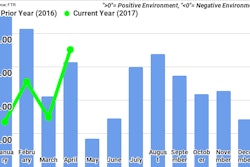The Federal Reserve reports trucking is keeping pace with the slight to moderate economic gains most U.S. regions have experienced since May.
Prices, wages, employment and consumer spending grew during the five-week period ending June 30 and is expected to continue upcoming months. The Fed summarized anecdotal information gathered from economic and business contacts in 12 service districts in this month’s Beige Book, published eight times a year.
The Richmond, Va., district reported stronger than seasonal increases in shipments during the second quarter. Growth has become less volatile, with sequential increases in shipments from March to June after an extended period of “up one month, down the next” for freight.
Although seasonal slowing in expected during the current quarter, most trucking executives said conditions “feel better than they have in a very long time.” They reported renewed momentum for shipments and expect “robust” freight volumes to grow.
Imports and exports gains were evident and widespread across shipping categories with spot freight prices rising, in some cases significantly. Manufacturers’ shipments increased while the typical seasonal slowdown softened new orders.
Since spring, Kansas City district transportation and warehousing firms have witnessed higher revenues and cargo volumes. Still, while parcel shipments and seaport cargo increased, air and trucking freight volumes were flat.
That district reported a commercial driver shortage, echoed by Cleveland’s district, where recruitment remained difficult despite pay increases. The latter region’s freight haulers experienced increased demand from oil and gas customers as well as construction material producers.
Still, “flat” was the way Minnesota district trucking contacts summarized activity and Dallas district transportation and warehousing companies described cargo volume and revenue since spring.
Finally, trucking contacts in Atlanta district reported notable increases in freight volume and tonnage and Chicago district freight costs rose slightly.










